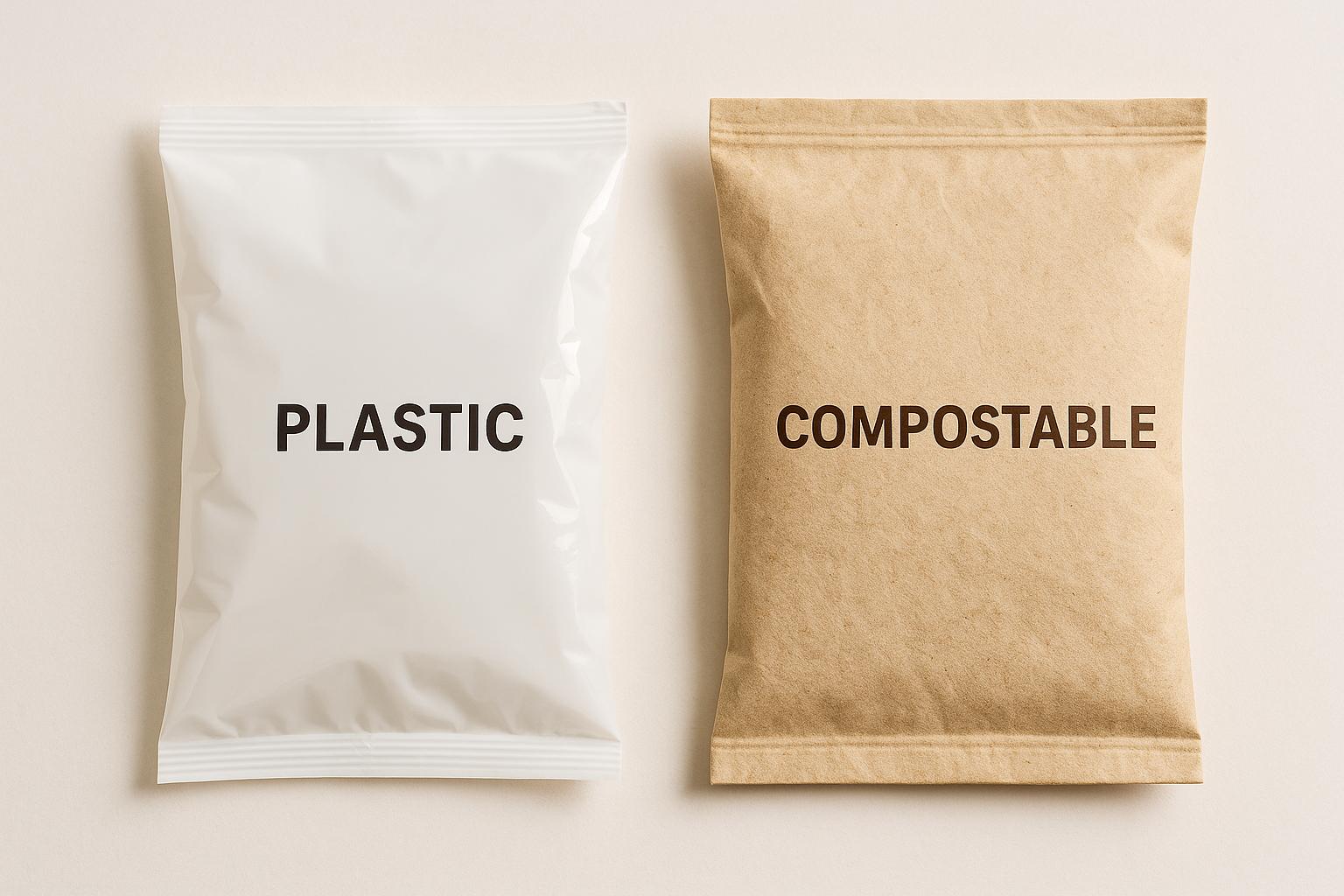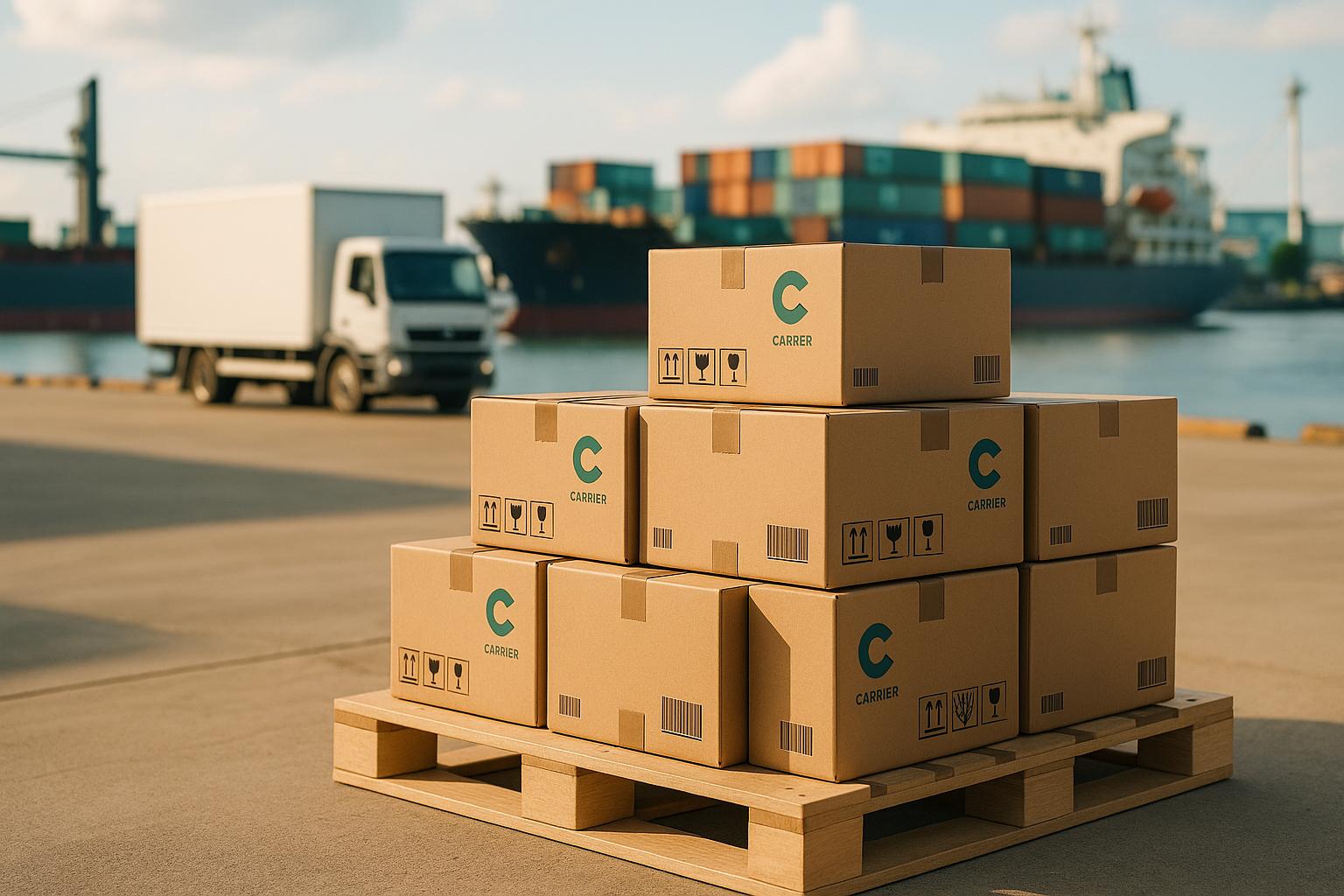Plastic packaging outperforms compostable alternatives in durability but lags in eco-friendliness. Here's the breakdown:
- Plastic excels in strength, moisture resistance, and oxygen barriers, making it ideal for long-term storage and tough conditions.
- Compostable materials are improving but often lack the resilience of plastic, especially in moisture-heavy or high-temperature environments.
- Shelf life differences: Plastic supports extended storage, while compostable options suit shorter cycles.
- Cost factor: Compostable packaging may cost more upfront but aligns better with sustainability goals.
Quick Comparison
| Feature | Plastic | Compostable |
|---|---|---|
| Strength | High tensile strength, resists punctures | Lower tensile strength, improving over time |
| Moisture Resistance | Excellent | Moderate, enhanced with coatings |
| Oxygen Barrier | Excellent for long-term freshness | Moderate, varies by material |
| Temperature Stability | Reliable across wide ranges | Sensitive to high temperatures |
| Shelf Life | Long-term storage | Short to mid-term storage |
| End-of-Life | Persists for centuries as microplastics | Breaks down into natural components quickly |
Plastic is a proven solution for durability, while compostable packaging is evolving to balance functionality and sustainability. Choosing the right option depends on your product's needs and your brand's priorities.
How Does Biodegradable Packaging Differ from Traditional Plastic Packaging? - Ecosystem Essentials
Material Strength: Compostable vs Plastic
When comparing the performance of traditional plastic to compostable packaging, the differences in material strength and durability are clear. While innovations are helping to close the gap, each material has its own strengths and limitations.
Physical Strength and Durability
Plastic packaging, such as polyethylene (PE) and polypropylene (PP), is known for its toughness. It can handle high tensile forces, resist punctures, and endure stacking pressures. For example, HDPE containers are designed to prevent small flaws from turning into larger tears when under stress. This durability makes plastic an excellent choice for products that might face rough handling during shipping or on retail shelves.
On the other hand, compostable materials typically have lower tensile strength. Plant-based PLA (polylactic acid) films, for instance, are less mechanically robust than plastic. However, advancements in material formulations and design have made compostable options suitable for many consumer goods. Paper-based compostable materials, while eco-friendly, lose strength when exposed to moisture, unlike plastic, which maintains its integrity. That said, new bio-based barrier coatings are improving the moisture resistance of compostable materials, allowing them to perform more like plastic in certain conditions.
Barrier Protection for Products
One major distinction between these materials lies in their ability to protect products from external elements. Traditional plastic films, like those made with ethylene vinyl alcohol (EVOH), excel at creating oxygen barriers that help preserve freshness over long periods. This makes them ideal for products that require extended shelf life.
Compostable packaging, however, generally offers less effective barrier protection. For example, basic PLA films allow more oxygen to pass through compared to conventional plastics, which can affect the shelf life of sensitive items. Similarly, uncoated paper-based compostable packaging provides minimal moisture protection, making it less suitable for products needing dry storage.
That said, compostable technology is advancing. Multi-layer films with plant-based barrier coatings now offer better oxygen and moisture resistance, expanding their usability. Still, temperature stability remains a challenge. Plastic packaging holds up across a wide range of temperatures, while some compostable materials may soften at higher temperatures, potentially weakening their protective qualities.
These differences significantly impact product shelf life and handling requirements. For businesses looking to make the switch to compostable packaging, working with experts like Paking Duck can help ensure the right materials are chosen for specific product needs. By aligning material capabilities with product demands, companies can transition to compostable solutions without sacrificing quality or performance.
Shelf Life and Product Protection
When it comes to packaging, shelf life plays a major role in preserving product quality and minimizing waste. Beyond material strength and barrier protection, the ability to maintain freshness over time is a key measure of a package's performance.
How Different Materials Impact Shelf Life
Plastic packaging is known for its durability and ability to shield products from oxygen, moisture, and light. These qualities make it highly effective at maintaining freshness and extending shelf life, even during long storage periods.
Compostable packaging, on the other hand, takes a more tailored approach. While some compostable films allow more oxygen to pass through compared to plastic, they can still provide adequate protection when matched to specific storage needs. For example, plant-based PLA works well for dry goods that don’t require heavy-duty barriers. Recent advancements in multi-layer compostable films with specialized coatings are improving moisture resistance, helping to close the performance gap. However, compostable materials often perform best in controlled storage environments.
The table below highlights how these materials compare in key performance areas.
Shelf Life Comparison Table
| Factor | Plastic Packaging | Compostable Packaging |
|---|---|---|
| Oxygen Barrier | Excellent protection against oxygen exposure | Moderate protection, depending on material |
| Moisture Protection | Consistently strong across various conditions | Effective, with performance enhanced by coatings |
| Temperature Range | Reliable across a wide range of temperatures | Can be sensitive to temperature changes |
| Shelf Life Extension | Ideal for long-term storage of sensitive products | Suitable for short to mid-term storage needs |
| Best Applications | Perfect for products requiring extended shelf life and strong barriers | Great for items with quicker consumption cycles |
| Environmental Sensitivity | Stable in diverse conditions | May need controlled environments for optimal performance |
Choosing the right packaging material often comes down to balancing shelf life requirements with sustainability goals. For products like fresh bakery items or seasonal goods with shorter consumption cycles, compostable packaging can deliver adequate protection while aligning with eco-friendly values. However, items that demand longer shelf life or higher levels of protection may still benefit from plastic’s proven reliability.
Brands aiming to shift toward sustainable options can benefit from working with experienced partners like Paking Duck. They can help identify compostable solutions that meet specific shelf life demands while ensuring product quality throughout the supply chain.
sbb-itb-e0a0838
Practical Use and Brand Applications
Switching to compostable packaging can shake up how businesses operate and produce their goods. Incorporating these materials often means adjusting production lines, upgrading equipment, and training staff to handle the new processes. These changes, while necessary, can feel overwhelming without the right expertise.
That's where working with packaging specialists, like Paking Duck, becomes invaluable. They help brands find compostable options that fit seamlessly into existing systems or provide the guidance needed to make essential adjustments, ensuring a smoother transition.
End-of-Life Performance and Impact
Decomposition and Impact Differences
When it comes to breaking down, plastic and compostable materials take very different paths. Plastic doesn’t biodegrade in the true sense - it breaks apart through processes like photodegradation and oxidation, resulting in microplastics that can linger in the environment for centuries. On the other hand, compostable materials follow a more natural route, breaking down into water, carbon dioxide, and nutrient-rich humus within just a few months under proper composting conditions.
End-of-Life Comparison Table
| Factor | Plastic Packaging | Compostable Packaging |
|---|---|---|
| Decomposition Timeline | Lasts for centuries as microplastic fragments | Breaks down within months in composting settings |
| End Products | Microplastics | Water, carbon dioxide, and humus |
These stark differences in how materials break down highlight the importance of choosing packaging that aligns with both environmental and functional priorities.
Choosing the Right Packaging for Your Brand
Deciding between compostable and plastic packaging means balancing durability needs with environmental priorities. The best choice depends on factors like the type of product, its shelf life, and your brand's core values.
When it comes to durability and shelf life, the material's performance varies depending on the application. For items that need extended shelf life or high barrier protection, plastic packaging often outperforms other options. Think about food products, moisture-sensitive electronics, or goods traveling long distances - plastic's sturdy protective qualities make it a reliable choice. On the other hand, brands prioritizing sustainability may view the environmental downsides of plastic as a dealbreaker. Compostable packaging is a better fit for products requiring moderate protection, such as fresh foods, cosmetics, or items sold in fast-moving retail environments.
Customization matters. Both plastic and compostable materials allow for tailored designs, but each offers distinct advantages. Plastic excels at accommodating complex shapes, advanced barrier coatings, and specialized closures. Compostable materials, however, shine with natural textures, eco-conscious printing techniques, and surface treatments that emphasize sustainability.
Cost considerations go beyond the sticker price. Compostable packaging often comes with higher upfront costs, but these can be offset by marketing benefits, consumer loyalty, and compliance with sustainability regulations. Plastic packaging, while typically more affordable per unit, may encounter growing challenges from regulatory restrictions and shifting consumer preferences.
Navigating these trade-offs can be challenging, but packaging specialists make the process easier. Paking Duck's consultation services help brands assess their unique needs - whether it's durability, shelf life, customization, or cost. Their factory-direct pricing model allows businesses to explore both plastic and eco-friendly packaging options without the usual markup.
Certifications also play a role in the decision-making process. Compostable packaging must meet standards like ASTM D6400 or BPI certification, which involve rigorous material selection and testing. Meanwhile, plastic packaging faces its own set of rules, particularly around recycling claims and material safety standards.
The smartest approach? Test both options. Real-world trials often uncover insights that technical specifications alone can’t provide. By testing, brands can ensure their packaging aligns with both functional needs and sustainability goals, striking the right balance between performance and environmental responsibility.
FAQs
How does compostable packaging compare to plastic in terms of environmental impact and decomposition?
Compostable packaging offers a cleaner alternative to traditional plastic, especially when considering how it breaks down and its impact on the environment. Under proper composting conditions, it typically decomposes within 45 to 180 days, leaving behind no toxic residues. This rapid breakdown helps curb long-term pollution. Compare that to traditional plastics, which can linger for centuries, often shedding harmful microplastics into ecosystems.
By breaking down naturally and efficiently, compostable packaging plays a key role in reducing environmental contamination. It also aligns with sustainable waste management goals, making it an appealing option for eco-conscious brands and consumers aiming to lessen their environmental impact.
What are the cost considerations for businesses switching from plastic to compostable packaging?
Switching to compostable packaging can lead to an immediate increase in costs, often ranging from 20% to 30%. For example, the price per unit might jump from $0.23 to $0.41, which can noticeably affect profit margins, especially for businesses handling large order volumes.
That said, these upfront costs often come with long-term advantages. Companies may save on waste management expenses and gain a stronger brand image by aligning with eco-conscious values. As more consumers prioritize sustainability, many businesses discover that this shift not only balances out the initial expense but also strengthens customer loyalty over time.
How can businesses ensure compostable packaging is durable enough for their products and maintains an adequate shelf life?
To make sure compostable packaging holds up to durability and shelf-life demands, businesses should opt for certified materials that meet established standards like ASTM D6400 or EN 13432. These certifications confirm the materials are built to perform under specific conditions while remaining environmentally friendly.
Equally important are proper storage practices. Store compostable packaging in dry, climate-controlled spaces to avoid premature breakdown. On top of that, using advanced packaging technologies - like features that control moisture and oxygen - can help keep products fresh and ensure the packaging remains sturdy and functional over time.







.svg.png)